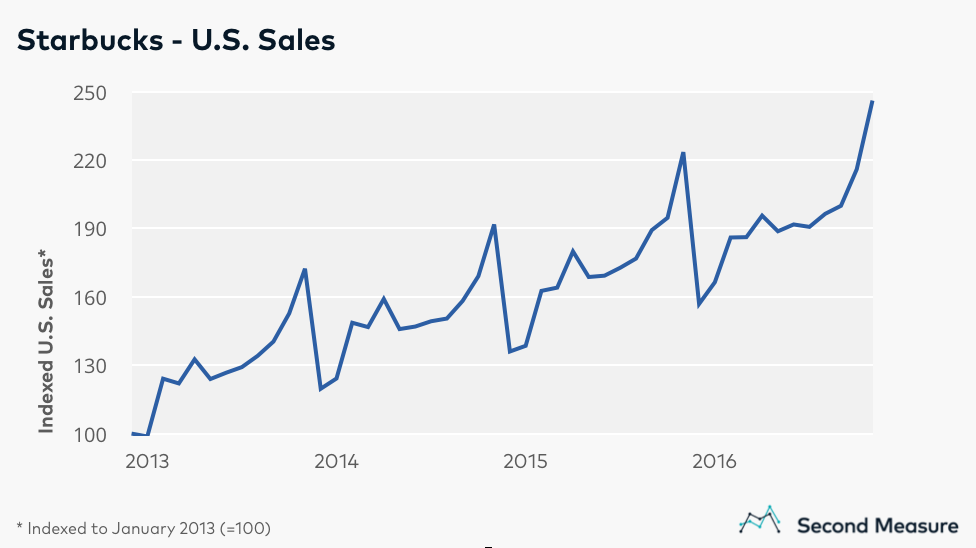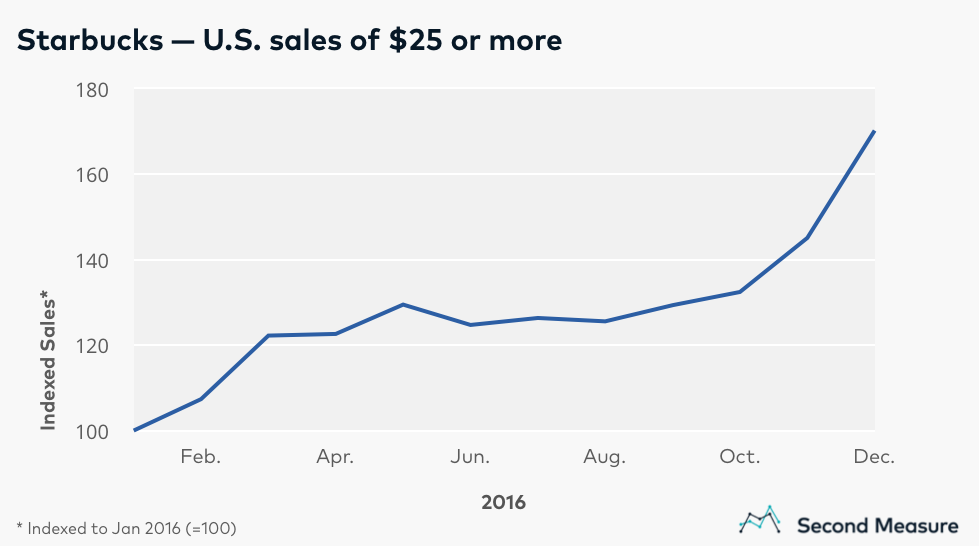NOTE: Bloomberg Second Measure launched a new and exclusive transaction dataset in July 2022. Our data continues to be broadly representative of U.S. consumers. As a result of this panel change, however, we recommend using only the latest posts in assessing metrics, and do not support referring to historical blog posts to infer period-over-period comparisons.
For more than a decade, its September return has marked the unofficial beginning of fall. Starbucks says it’s their most popular seasonal beverage of all time. It even has an official Twitter account with more than 113,000 followers. It’s the Pumpkin Spice Latte. (#PSL, to those in the know.)
On Facebook today, Starbucks began celebrating the drink’s triumphant return with a livestream video, presumably leading up to the announcement of PSL’s release date. It all makes us wonder whether hoards of pumpkin-spice fans will soon be lining up and sending sales through the roof. But our Starbucks consumer-spending data for past Septembers reveals it’s never the coffee giant’s top month for sales or customer traffic.

For the last four years, September has been Starbucks’ fourth or fifth best month for U.S. in-store sales. It ranks in a similar spot among months with the highest number of customers. Holding the top places on both lists are the truly fall and holiday months of October, November and – Starbuck’s real sales juggernaut – December.
The PSL is available throughout that time period, so fans of the drink know they don’t need to fill up on it right when it debuts. But that doesn’t mean they’re not excited for the annual premier. Last year, Starbucks announced the latte’s return on Sept. 1, and the next day was the company’s tenth busiest day of the year in terms of number of customers.
Why December sales are steaming hot
Annually, the highest-sales week of the year at Starbucks falls about two weeks before Christmas. In 2016, December sales were 14 percent higher than in November, the second-highest sales month, and 58 percent higher than in January, the lowest month.
In our estimation, strong December sales have very little to do with pumpkin or any seasonal drink at all. Exhausted holiday shoppers needing a caffeine fix are certainly a factor, but there’s something more important that sets December purchases apart. The amounts many people spend at Starbucks this time of year are significantly higher than the cost of an average cup of coffee and pastry. Customers are shopping for gift cards and other coffee-related holiday presents.
In December, the number of Starbucks purchases of $25 or more jumps dramatically. In 2016, the spike was nearly 50 percent above the average for the first 11 months of the year.

Do we all stop drinking coffee in January?
Almost as notable as Starbucks’ December spike is the January crash. January is the lowest-sales month of the year, and it’s hard to pinpoint exactly why. Plausible theories include customers’ New Year’s resolutions to reign in discretionary spending or unhealthy eating habits (both of which, research shows, are very common). But another explanation for the January cliff might be that patrons are still visiting Starbucks, they’re just spending all those newly minted gift cards instead of dollars.
Sales begin to tick up again in February, right around the time when the gift card balances – or the will to keep up New Year’s resolutions – probably run out.
If you’re interested in seeing sales trends – and lots of other very cool consumer-spending data – for thousands of companies like Starbucks, we’d love to hear from you. Request a demo today >>>
